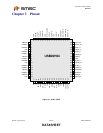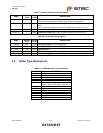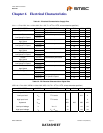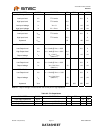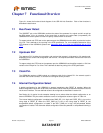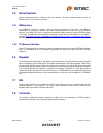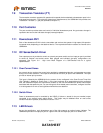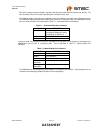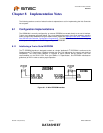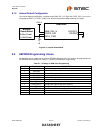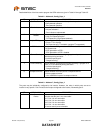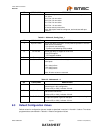
4-Port USB 2.0 Hub Controller
Datasheet
Revision 1.63 (03-30-07) Page 16 SMSC USB20H04
DATASHEET
Chapter 7 Functional Overview
Figure 2.1 shows the functional block diagram of the USB 2.0 Hub Controller. Each of the functions is
described in detail below.
7.1 Bus-Power Detect
The VBUSDET pin on the USB20H04 monitors the state of the upstream V
BUS
signal and will not pull-up
the DP0 resistor if V
BUS
is not active. If V
BUS
goes from an active to an inactive state (not powered), the
USB20H04 will remove power from the DP0 pull-up resistor within 10 seconds.
To support a dual-role OTG host on the upstream port, the USB20H04 has the ability to pulse the inactive
V
BUS
line. This is defined as V
BUS
pulsing in the OTG specification. For a more detailed discussion of the
OTG features of the USB20H04, please see “Application Note 10.4 Using the USB20H04 with an OTG
Host”.
7.2 Upstream PHY
The upstream PHY includes the transmitter and receiver that operate in high-speed or full-speed mode,
depending on the current hub configuration and the host. The required termination resistors are internal to
the USB20H04.
To support a dual-role OTG host on the upstream port, the USB20H04 has the ability to attach a 1.5K ohm
resistor to the DP0 pin for 5 to 10ms. This is defined as data-line pulsing in the OTG specification.
7.3 Clock/PLL
The USB20H04 requires a 24MHz signal as a reference clock for the internal PLL. An external crystal is
used with the internal oscillator, or an external clock signal can be provided.
7.4 Internal Configuration Select
A default configuration for the USB20H04 is present immediately after RESET_N negation. When the
default configuration values will not be used, user defined values must be provided from an external source
via the serial interface. The user defined values to be configured are described in section 8.2.
See Section 8.1 for typical circuit examples showing how to select either the default configuration or an
external EEPROM. The pins used to select the source of configuration values are given in Table 4.2.
The internal default configuration is enabled when SMB_SEL_N is high and CS/EE_SEL is low on the
rising edge of RESET_N. When the SELF_PWR pin is low on the rising edge of RESET_N, the
bus-powered default configuration is loaded. If the SELF_PWR pin is high, the self-powered default
configuration is loaded. This allows the default configuration to be bus-powered or self-powered following a
reset.



